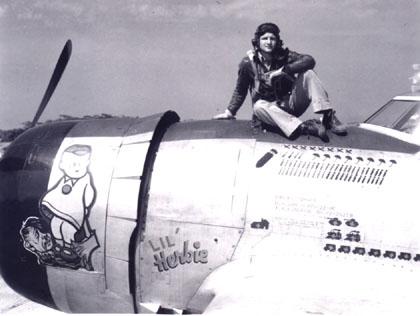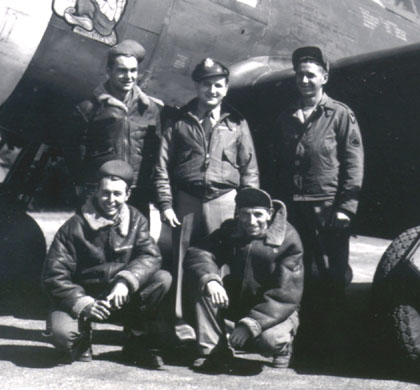Like so many of us, Herb Stachler’s path to becoming a fighter pilot was filled with obstacles. In 1940 the draft had been implemented, which required young men to serve one year in military service, after which they would return to civilian life. In early 1941, Herb was advised by his draft board that he would be called to active duty in about six months. Rather than start his career as a toolmaker and then have it interrupted in a few months, Herb decided to enlist, and get his year of military service out of the way. Then along came the Japanese attack on Pearl Harbor, and all men on active duty were frozen in place “for the duration.”
Around mid-July 1942, the Army Air Corps started accepting applications for pilot training from men currently on active duty. Herb immediately applied, and was accepted pending his passing the Air Corps physical. The problem he faced was that he was 5′ 3½” tall, and the Air Corps would not accept anyone who was less than 5′ 4″ tall! So Herb embarked on a process of “stretching” himself. He would hang from a horizontal bar every day in an effort to let gravity help him stretch his body, and help him “grow” that additional half inch. Standing as tall as he could when he took his Air Corps physical, Herb passed and was accepted into the cadet program.
The process had now begun. He successfully completed pre-flight training, the primary, basic and advanced flight training. He received his pilot wings and was commissioned a 2nd Lieutenant at Marianna, Florida, on July 28, 1943. The long and challenging goal of becoming a fighter pilot had now been realized, as 2nd Lieutenant Herbert Stachler was now assigned to an air base at Richmond, Virginia, to be introduced to the mighty P-47 Thunderbolt! All 5 feet 4 inches of him!!
At the end of fighter transition training, Herb was assigned to the 366th FighterGroup at Wilmington, North Carolina, and he shipped overseas with them in January 1944. The Group was sent to Thuxton Air Force Base near Andover in southern England, and after additional training, they started flying combat missions over western Europe in March 1944.
Herb had been assigned his own P-47, so he had to decide what to name it. Back then, there was a comic strip called “Lil’ Herbie” about a little boy and his many adventures. One guy in the 366th was quite an artist, so he painted the comic strip character on the nose of the plane, holding Hitler’s head and a bloody axe, with the title “Lil’ Herbie” above it. That, coupled with the fact that Herb was one of the smallest fighter pilots, made “Lil’ Herbie” the perfect name for the plane.

During the next 12 months, Herb Stachler was involved in brutal, intense war, and before it was over, he had flown 102 combat missions. He participated in every major campaign on the Western Front, including the invasion of France on June 6, 1944, the breakout from Normandy, the Ardennes, and the Battle of The Bulge. During the time he was with the 366th Fighter Group, 90 of his fellow pilots were lost to enemy action. But during this period, he had made a substantial contribution to the outstanding results achieved by the 366th in the European theater of Operations. He had flown missions with them from England, then landing strip A-1 in Normandy, then near Dreux, France, A-70 near Laon, France, and Y-29 near Maastricht, Holland. By the time he was sent back to the States in March 1945, he had seen it all and had done most of it.
On the night of June 5/6, 1944, along with other personnel of the 366th FighterGroup, he had watched and listened to the massive armada of C-47s carrying paratroopers, or towing gliders loaded with paratroopers, as they went over the airfield on their way to Normandy for the invasion. Then as dawn came, he was part of the first mission flown by the 366th over the invasion area. He knew he was seeing history in the making, and he was glad he was able to be so heavily involved.
At the opening of this story I have written “. . . The First Fighter Pilot To Land in France After The Invasion?” Let’s look at the circumstances that lead me to considering this possibility, as described in Herb’s own words:
“On June 11, 1944, five days after D-Day, we were flying top cover along Normandy Beach at about 4,000 feet, when there was a loud crack and pieces of shrapnel flew back into my cockpit. One piece went through my pant’s leg. I looked out and saw damage to the wing. Just then my element leader shouted on the radio, ‘Herbie, there’s a German on your tail!’ At the moment I was flying ‘tail-end Charlie’ and enjoying the scenery, when this FW-190 sneaked up behind me and tried to pick me off. If that guy is alive today, he is probably wondering why I didn’t go down – he had a perfect shot at me. There was no evasive action on my part, since I did not know that I was being attacked. In an instant he had disappeared, and then I noticed that my oil pressure was dropping and that I was losing hydraulic pressure as well. Next, I noticed there was fluid on the floor. My first thought was gasoline, since my main 300-gallon tank was right below me. It proved to be hydraulic fluid though, but I knew I couldn’t make it back to England.
There was an allied air base under construction atop the cliffs, inland from the beach. I told my element leader that without oil and hydraulics I would have to land now, so I set down on this runway. This got pretty tricky, because without hydraulic fluid I had no brakes and no flaps. Fortunately – even without hydraulic pressure – the landing gear fell down and locked into place, but without flaps I had to land at 180 mph.
It took a little ‘bump’ of the plane to make sure the gear locked, but this was standard procedure. The base was a ‘chicken-wire’ airstrip, our pet name for wire landing mesh that looked like large hardware cloth. After I landed and parked, I got out of my plane and looked it over carefully. When I saw all the damage, I started to shake, and I shook uncontrollably. I had been that close to ‘buying the farm.’
The engine is attached to the fuselage with four tubular frame motor mounts, one of which was shot through. The ground crew at the landing strip was unable to repair it, but they did fix the oil lines and the hydraulic lines. They also patched up the fuselage where the 20mm explosive projectile came through. The holes in the wings could wait until I got back to England. When I was finally able to return to our base at Thruxton a few days later, I found that the outfit was in the process of moving to Normandy, Landing Strip A-1, the runway where I had made my forced landing!”
– Herb Stachler
Was Herb Stachler the first fighter pilot to land in France after the invasion? And get back to England with his plane? I have researched all this, and I do not find anything that would indicate otherwise. There were planes that bellied in and the pilot survived, but I find no record of anyone who landed a fighter plane in Normandy prior to June 11, 1944, and then after his plane was given temporary repairs, flew it back to England.
Herb Stachler arrived in England as a 2nd Lieutenant, and when he returned to the States on the Queen Mary in March 1945, he was a Captain. I flew with him on several combat missions and can attest to his skill as a fighter pilot. He was one of the smallest fighter pilots in the Air Corps, but he had one of the biggest hearts. He flew with courage, and he never backed off on a mission.

Herb and his wife, Dorothy, were married in 1946, and had ten children. They have had a good life, but for the past five years, Dorothy has been a victim of progressive Supranuclear Palsy (PSP), a rare, but devastating, disease. Herb has devoted his time and energy to taking care of her. In a recent letter to me he wrote, “I pray to God every day for health and energy so I can continue to care for her.” Such is the character of the little big man, Captain Herbert Stachler,(Retired).

